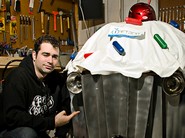
There is a method behind the madness associated with creations like a
Red Green Robot or a Cupcake Electric Vehicle, we promise. Their
inventor, i3 Detroit hackerspace co-founder Nick Britsky, is here to
talk this week about his community toolbox, the Maker Movement, and the
state of DIY.
Post 2: The Maker Movement
Posted By: Nick Britsky
Posted: 9/10/2010
In my last post I talked about the growth of hackerspaces in Detroit. This expansion is mirrored in the world with more than 400 registered locations on Hackerspaces.org. A number of causes have been attributed back to the increase ranging from the next evolution of open source production, resurgence in the D.I.Y. mindset and recycling as well as something called the Maker Movement.
Started by Mr. Jalopy of the Hoopty Rides blog, the Maker Movement is the infusion of creativity and ingenuity in manufacturing at a grassroots level. Imagine your neighbor next door building a giant 7-foot foam Twinkie with gas engine locomotion and a pneumatic Twinkie launcher built in it. The market for this is probably pretty slim at best. It is also very unlikely that the Detroit Institute of Arts will be taking it either. The only reason he would build such a thing is because he wanted to. The journey of building the car is the most interesting part of the process. Learning how to plumb pneumatic parts, keep a small engine running and select the material that best resembles a sponge cake are all examples of the constant learning that people are embarking on for the Maker Movement. These people are known as Makers and they are continuing the tradition of manufacturing knowledge & skills that grew from Detroit.
Hundreds of web sites and blogs are fueling this movement and adding projects and skills to the public realm. Make and Craft magazines are the biggest sites drawing upon the Internet sphere for some of the best Maker writers.
However, this quest for whimsical design and re-imagining everyday objects is leading to some great businesses, too. Makers are discovering that with recent technological advancements, the web and personal computers, they can build tools and equipment that were financially restrictive only 10 years ago. MakerBot Industries, as an example, continues to improve the concept of desktop rapid prototyping with their CupCake CNC. A used industrial rapid prototype can be much more than $10,000 and is utilized to print 3D plastic parts for use in prototype builds. With this desktop version at around $1,000, you can build printer parts for your own projects at a fraction of the cost. Makers are using this to print gears and brackets right on their desktops. The founder of MakerBot, Bre Pettis, is of course a Maker himself and started all of this out of his shop. Maintaining the Maker spirit, all of his designs are available if you want to venture out and build it yourself.
Detroit is already starting to see the benefits of this movement, but it could be more. People are now, more than ever, empowered to use their creativity to make things at home. The resources and information on the web can turn anyone in to an apprentice crafter, machinist or welder. (Though nothing beats hands-on training.) As we continue to discover and explore this trend, people will want to learn more. Seek out those resources at community colleges, community centers and hackerspaces to perfect your Maker skills – maybe one day you can turn it into a small business of your own.